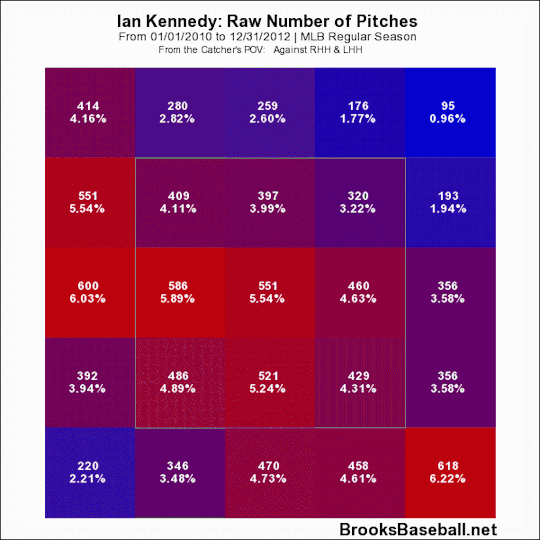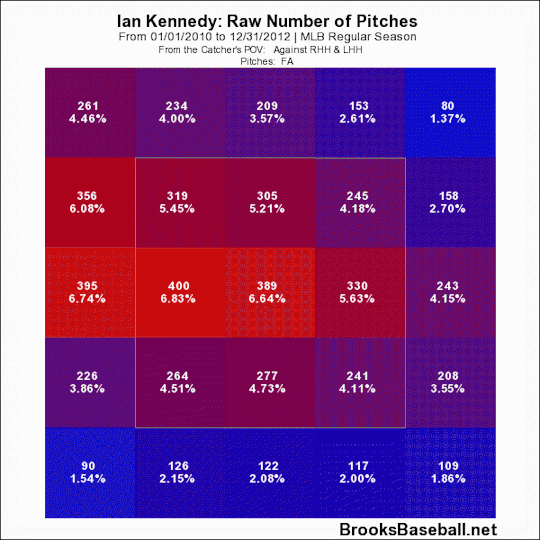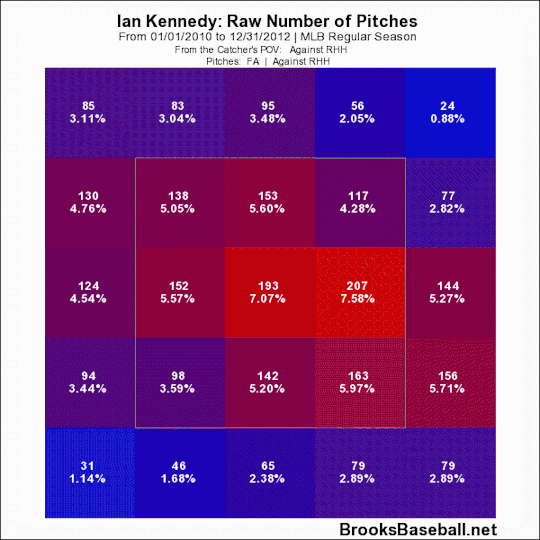Author’s note: this post was originally published prior to the Royals signing Ian Kennedy in January. It has been edited to reflect that move.
It seems convenient to break Ian Kennedy’s past into two sections: 2010-2012, and 2013-2015. In the first time frame, Kennedy was quite good. In the second time frame, Kennedy was much less good. Granted, his 2014 season was respectable, even more so when looking at his peripherals (FIP- of 88), but overall the last three years have been difficult for the 31-year old righty.
From 2010-2012, Kennedy had a 3.55 ERA and a 3.84 FIP. Since then, his ERA is 4.25, with a FIP of 4.06, and he called pitcher-friendly Petco Park his home stadium in the last two-plus seasons. It is encouraging that Kennedy’s been able to post an excellent strikeout rate in those seasons (23.1 percent) along with a solid walk rate (8.3 percent), but his run prevention numbers still suffered. That’s because he allowed more hits and home runs, which are typically things of which a pitcher wants to allow fewer.
In his last three seasons, Kennedy’s allowed 8.7 hits and 1.21 dingers per 9 innings, compared to 8.1 hits and 1.05 dingers per 9 from 2010-2012. That may not seem like a huge increase, but combined with a much lower strand rate (71.6 percent after 76.5 percent earlier), it’s easy to understand what led to more runs being scored with Kennedy on the mound.
However, those reasons are only on the surface, so let’s see what led to those differences, to try and figure out what Kennedy may need to change to get back to his pre-2013 level of run prevention.
The first step is to look at Kennedy’s pitch usage, to see if that could be the underlying cause. Long story short: it isn’t. He relies mostly on his four-seam fastball, while mixing in a changeup and curveball, along with a cutter and an occasional sinker. In the last three years he’s cut down on his sinker usage and thrown a few more four-seamers and curves, but overall his pitch mix is pretty similar.
Declining velocity could be another indicator of struggles, but interestingly enough, Kennedy’s actually added some heat to his fastball recently, topping 92 mph after sitting around 90.6 mph earlier. And he also hasn’t lost any movement to his pitches, other than his cutter, so that doesn’t seem to explain anything.
His pitches have gotten hit a bit harder, though. Kennedy allowed a .253 average and a .430 slugging percentage on his fastball before 2013, and a .264/.466 line after. It’s a similar story with his main offspeed pitches as well: .203/.343 on his change before 2013, .234/.433 after; .210/.319 on his curve before 2013, .258/.379 after. His cutter and sinker have gotten better results, but considering he throws them less than 8 percent of the time, it’s not a significant trend.
So Kennedy’s stuff seems to be better than it used to be, but batters are teeing off on him more frequently. Why? It appears to be a matter of location.
Take a look at Kennedy’s overall zone profile during the two time frames, courtesy of Brooks Baseball:

The difference is pretty stark. Kennedy used to challenge hitters more often in the zone, but for whatever reason, he seemed hesitant to attack that area more recently. From 2010-2012, 52.3 percent of his pitches were in the zone. Since then, he’s at 49.2 percent. But it’s not just the in-zone and out-of-zone differences. More specifically, Kennedy has greatly altered his approach when throwing his primary pitch.

As a guy who generates a lot of fly balls, you expect to see more pitches up in the zone. But in the second image, you can see a definite shift in Kennedy’s location. That shift is even more pronounced when looking at his approach when facing right-handed hitters.

Again you notice a lack of aggressiveness, particularly on the inner half of the plate. He also didn’t elevate his fastball as often in the second time frame. That combination partially explains why Kennedy didn’t get as many infield fly balls as he used to (8.8 percent infield fly ball rate recently, 11.1 percent before). The change in location has resulted in more line drives and fewer popups when his fastball is put in play, and of course, more solid contact is not what a pitcher is looking for.
Kennedy has also given up much more solid contact on his changeup, particularly against righties. In the last three years, same-side batters have a .203 average and a .426 slugging percentage against the change, after only mustering a .155/.272 line from 2010-2012. Unlike his fastball, Kennedy has been throwing more changeups just off the inside edge of the plate, while he used to keep that pitch away from righties.
Lefties also have had more success against him, especially against his fastball (.253 AVG, .502 SLG), but it does seem like better location against righties could have a significant impact on Kennedy’s effectiveness.
As a flyball pitcher, Kennedy is always going to surrender some home runs. That’s a feature, not a bug. And fly balls aren’t necessarily a bad thing, but there has to be some weaker contact mixed in to counteract the dingers. Think of a guy like Chris Young. He’ll give up his share of home runs, but because he can generate so many popups, there aren’t as many runners on base when the homers are hit.
Kennedy doesn’t have to become exactly like Young, and he shouldn’t. Kennedy will miss more bats than Young, and he won’t get as many fly balls. However, if Kennedy gets back to attacking the inner half against righties (something the Royals preach to their pitchers) he’ll likely start to see weaker contact, more popups, and less traffic on the bases.
I’ve also yet to mention the fact that the Royals outfield defense is a drastic improvement over the Padres’. Justin Upton and Melvin Upton were fine defensively, but they’re not Alex Gordon and Lorenzo Cain, and Jarrod Dyson is the Ferrari to Matt Kemp’s mid-80’s station wagon. Kennedy will feel much better when a ball heads for the outfield with the Royals’ defense behind him.
Then there’s the Dave Eiland Effect. Eiland is a certified wizard, so Kennedy should take a large step forward after a conversation or two with his new pitching coach.
He’s been quite durable, making at least 30 starts in the last 6 seasons, and while he did deal with a hamstring injury last year, his arm appears to be in good shape. And considering Kennedy’s struggles in the past few years should be fixable, he seems like a great fit as the Royals’ third or fourth starter.
